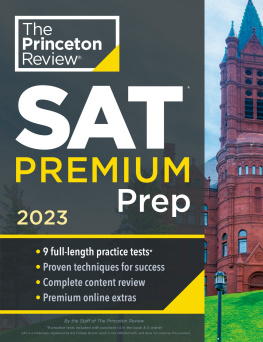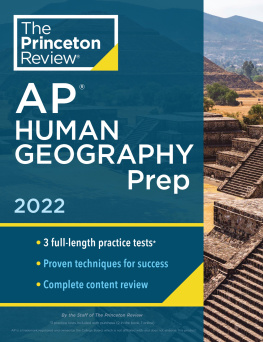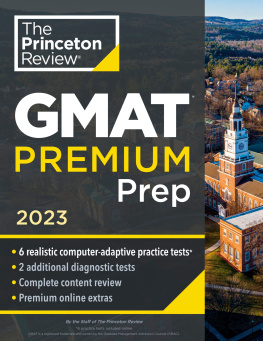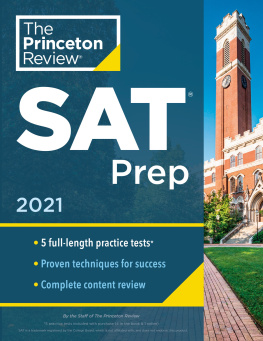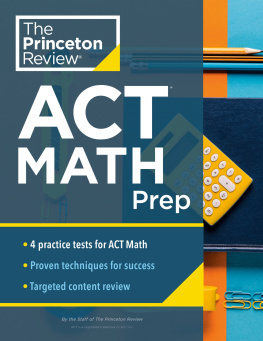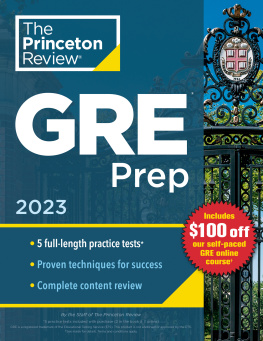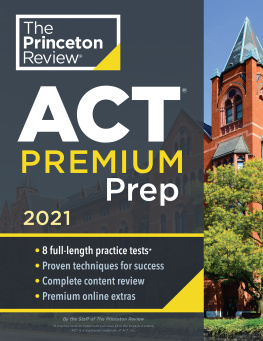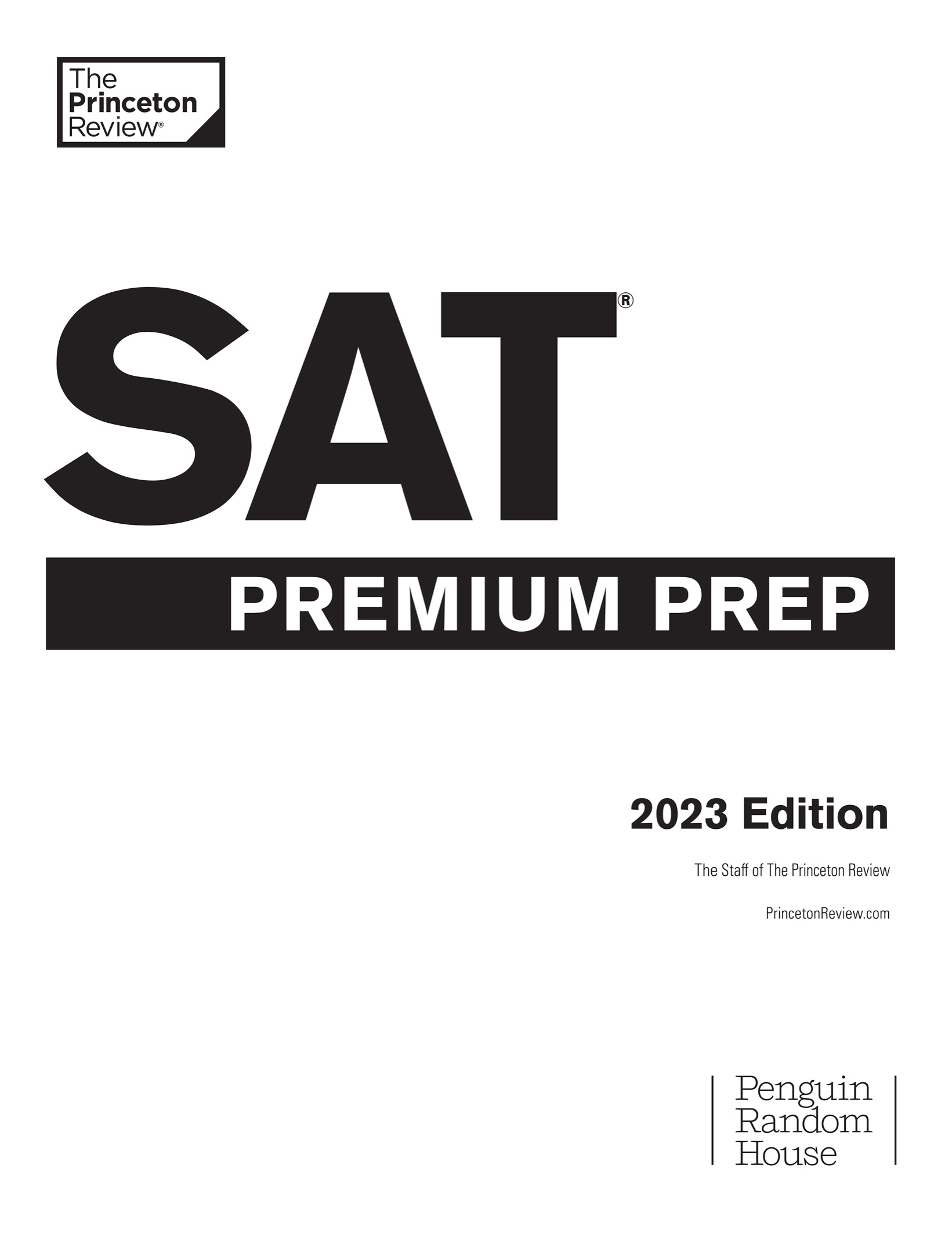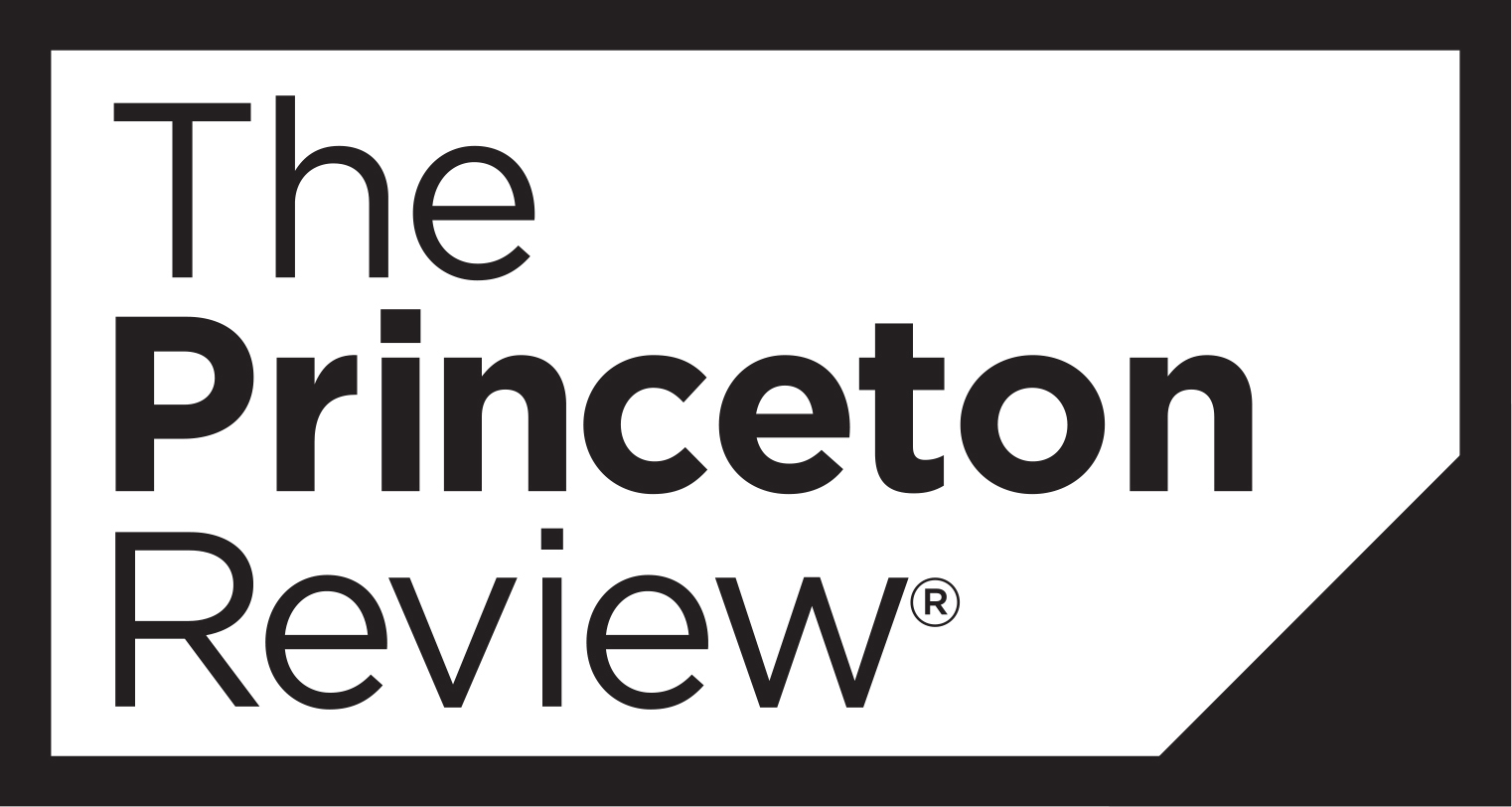Editorial
Rob Franek, Editor-in-Chief
David Soto, Senior Director, Data Operations
Stephen Koch, Senior Manager, Data Operations
Deborah Weber, Director of Production
Jason Ullmeyer, Production Design Manager
Jennifer Chapman, Senior Production Artist
Selena Coppock, Director of Editorial
Aaron Riccio, Senior Editor
Meave Shelton, Senior Editor
Chris Chimera, Editor
Orion McBean, Editor
Patricia Murphy, Editor
Laura Rose, Editor
Alexa Schmitt Bugler, Editorial Assistant
Penguin Random House Publishing Team
Tom Russell, VP, Publisher
Alison Stoltzfus, Senior Director, Publishing
Brett Wright, Senior Editor
Emily Hoffman, Assistant Managing Editor
Ellen Reed, Production Manager
Suzanne Lee, Designer
Eugenia Lo, Publishing Assistant
The Princeton Review
110 East 42nd Street, 7th Floor
New York, NY 10017
Email:
Copyright 2022 by TPR Education IP Holdings, LLC. All rights reserved.
Published in the United States by Penguin Random House LLC, New York, and in Canada by Random House of Canada, a division of Penguin Random House Ltd., Toronto.
Terms of Service: The Princeton Review Online Companion Tools (Student Tools) for retail books are available for only the two most recent editions of that book. Student Tools may be activated only once per eligible book purchased for a total of 24 months of access. Activation of Student Tools more than once per book is in direct violation of these Terms of Service and may result in discontinuation of access to Student Tools Services.
ISBN9780593450581
Ebook ISBN9780593450987
SAT is a trademark registered by the College Board, which is not affiliated with, and does not endorse, this product.
The Princeton Review is not affiliated with Princeton University.
Permission has been granted to reprint portions of the following:
The Windshield-Pitting Mystery of 1954. 2015 National Public Radio, Inc. Excerpts from news report titled The Windshield-Pitting Mystery Of 1954 by Linton Weeks was originally published on NPR.org on May 28, 2015, and is used with the permission of NPR. Any unauthorized duplication is strictly prohibited.
Priit Vesilind with James and Maureen Tusty, The Singing Revolution. 2008 by Sky Films Incorporated. www.singingrevolution.com.
Hazy Days in Our Parks 2015 Charles Petit. Excerpt from Hazy Days in Our Parks by Charles Petit originally published by Smithsonian Magazine in June 2005.
Gardners Art Through the Ages by Horst De La Croix, Richard G. Tansey, Diane Kirkpatrick. 9th edition, 1991. Copyright 1991 by Harcourt Brace Jovanovich, Inc. Republished with permission of Cengage Learning SO. Permission conveyed through Copyright Clearance Center, Inc.
The Parthenon FriezeAnother View. 1977 by John Boardman.
The Creators: A History of Heroes of the Imagination by Daniel J. Boorstin, copyright 1992 by Daniel J. Boorstin. Used by permission of Random House, an imprint and division of Penguin Random House LLC. All rights reserved. Any third party use of this material, outside of this publication, is prohibited. Interested parties must apply directly to Penguin Random House LLC for permission. Also used by permission of The Orion Publishing Group, London.
Tiny brains, but shared smarts, from the National Science Foundation, June 17, 2015. Reprinted with permission.
I wrote my own speech once. It didnt sound like me at all! Reprinted by permission of CartoonStock.com.
Telehealth expansion needs payment, coverage policy advances, by Dr. Nabil El Sanadi. Reprinted with permission, Modern Healthcare September 12, 2015. Crain Communications, Inc.
How To Fly A Horse: The Secret History of Creation, Invention, and Discovery. 2015 by Kevin Ashton.
Free Upgrades, Unfortunately by Elsa Youngsteadt. Copyright 2006 by American Scientist. Reprinted with permission of American Scientist.
Fill up your gas tank with bamboo? by Joe Turner, Science, February 2, 2015. Reprinted with permission of AAAS.
What Darwin Didnt Know by Thomas Hayden. February 2009. Smithsonian magazine.
What Happens If GPS Fails? by Dan Glass. The Atlantic, June 13, 2016. Reprinted by permission of Copyright Clearance Center.
Excerpt from The Matter Myth: Dramatic Discoveries that Challenge our Understanding of Physical Reality, by Paul Davies and John Gribbin. Copyright 1991 by Orion Productions and John Gribbin. Reprinted with the permission of Simon & Schuster, Inc. All rights reserved.
Scientists Discover Childrens Cells Living in Mothers Brains, by Robert Martone. Originally published December 4, 2012 in Scientific American. Copyright 2012 Scientific American, a division of Nature America, Inc. All rights reserved.
Copyright, Imperial College London. Asteroid killed off the dinosaurs, says international scientific panel. Science Daily. Reprinted with permission.
The Dying of the Dead Sea by Josh Hammer. 2005 by Smithsonian magazine.
In Humans and Animals, Social Learning Drives Intelligence 2018 Sussex Publishers, LLC (Psychology Today)
Birth of New Neurons in the Human Hippocampus Ends in Childhood by Nicholas Weiler. March 2018 by University of California San Francisco.
Adult neurogenesis in humans: Dogma overturned, again and again? by Laura C. Andreae. 2018 by Science Translational Medicine
Why We Sleep Badly on Our First Night in a New Place by Ed Yong. 2018 by The Atlantic Monthly Group.
Editor: Chris Chimera
Production Editors: Liz Dacey and Emily Epstein White
Production Artist: Jason Ullmeyer
Cover art by Paul Brady / Alamy Stock Photo
Cover design by Suzanne Lee
a_prh_6.0_140224945_c0_r0
Acknowledgments
An SAT course is much more than clever techniques and powerful computer score reports. The reason our results are great is that our teachers care so much about their students. Many teachers have gone out of their way to improve the course, often going so far as to write their own materials, some of which we have incorporated into our course manuals as well as into this book. The list of these teachers could fill this page.
Special thanks to all those who contributed to this years edition: Sara Kuperstein, Amy Minster, Scott ONeal, Cynthia Ward, Anne Bader, Gabby Budzon, Brittany Lee, Jomil London, Jason Morgan, Jess Thomas, and Chris Vakulchik.
We are also, as always, very appreciative of the time and attention given to each page by Jason Ullmeyer, Liz Dacey, Emily Epstein White.
Finally, we would like to thank the people who truly have taught us everything we know about the SAT: our students.
Contents
Foreword
Welcome to Princeton Review SAT Prep! The SAT is not a test of aptitude, how good of a person you are, or how successful you will be in life. The SAT simply tests how well you take the SAT. And performing well on the SAT is a skill, one that can be learned like any other. The Princeton Review was founded more than 35 years ago on this very simple idea, andas our students test scores showour approach is the one that works.

